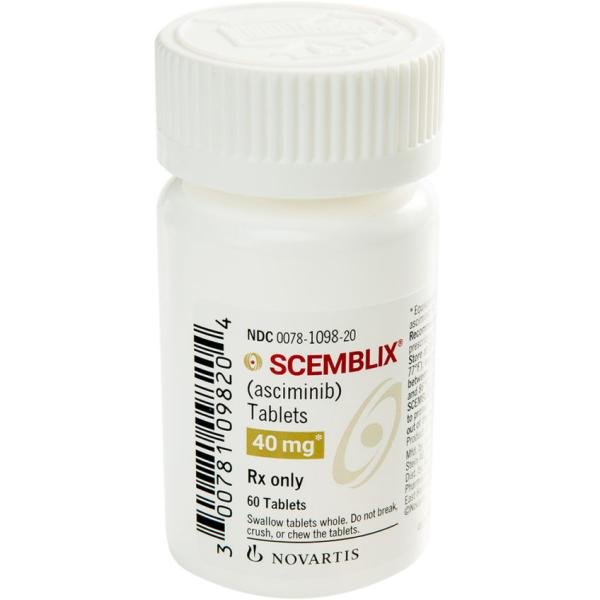Scemblix Dosage
Generic name: ASCIMINIB HYDROCHLORIDE 20mg
Dosage form: tablet, film coated
Drug class: BCR-ABL tyrosine kinase inhibitors
Medically reviewed by Drugs.com. Last updated on Jun 18, 2025.
2.1 Recommended Dosage in Patients with Newly Diagnosed or Previously Treated Ph+ CML-CP
The recommended dose of SCEMBLIX is 80 mg taken orally once daily at approximately the same time each day or 40 mg orally twice daily at approximately 12-hour intervals. The recommended dose of SCEMBLIX is taken orally without food. Avoid food consumption for at least 2 hours before and 1 hour after taking SCEMBLIX.
Continue treatment with SCEMBLIX as long as clinical benefit is observed or until unacceptable toxicity occurs.
2.2 Recommended Dosage in Patients with Ph+ CML-CP with the T315I Mutation
The recommended dose of SCEMBLIX is 200 mg taken orally twice daily at approximately 12-hour intervals. The recommended dose of SCEMBLIX is taken orally without food. Avoid food consumption for at least 2 hours before and 1 hour after taking SCEMBLIX.
2.3 Missed Dose
Once Daily Dosage Regimen: If a SCEMBLIX dose is missed by more than approximately 12 hours, skip the dose and take the next dose as scheduled.
Twice Daily Dosage Regimens: If a SCEMBLIX dose is missed by more than approximately 6 hours, skip the dose and take the next dose as scheduled.
2.4 Dosage Modifications
Dosage Modifications for Patients with Newly Diagnosed or Previously Treated Ph+ CML-CP
For the management of adverse reactions, reduce the SCEMBLIX dose as described in Table 1.
Dosage Modifications for Patients with Ph+ CML-CP with the T315I Mutation
For the management of adverse reactions, reduce the SCEMBLIX dose as described in Table 1.
| Dosage reduction | Dosage for Patients with newly diagnosed or previously treated Ph+ CML-CP | Dosage for patients with Ph+ CML-CP with the T315I mutation |
| First |
|
160 mg twice daily |
| Subsequent reduction | Permanently discontinue SCEMBLIX in patients unable to tolerate 40 mg once daily OR 20 mg twice daily. | Permanently discontinue SCEMBLIX in patients unable to tolerate 160 mg twice daily. |
The recommended dosage modifications for the management of selected adverse reactions are shown in Table 2.
| Abbreviations: ANC, absolute neutrophil count; PLT, platelets; ULN, upper limit of normal. aBased on Common Terminology Criteria for Adverse Events (CTCAE) version 4.03. |
|
| Adverse reaction | Dosage modification |
| Thrombocytopenia and/or neutropenia | |
| ANC less than 1 x 109/L and/or PLT less than 50 x 109/L | Withhold SCEMBLIX until resolved to ANC greater than or equal to 1 x 109/L and/or PLT greater than or equal to 50 x 109/L. If resolved:
|
| Asymptomatic amylase and/or lipase elevation | |
| Elevation greater than 2 x ULN | Withhold SCEMBLIX until resolved to less than 1.5 x ULN. If resolved:
|
| Non-hematologic adverse reactions | |
| Grade 3a or higher | Withhold SCEMBLIX until recovery to Grade 1 or less. If resolved:
|
More about Scemblix (asciminib)
- Check interactions
- Compare alternatives
- Pricing & coupons
- Reviews (1)
- Drug images
- Side effects
- During pregnancy
- FDA approval history
- Drug class: BCR-ABL tyrosine kinase inhibitors
- Breastfeeding
- En español
Patient resources
Professional resources
Related treatment guides
See also:
Further information
Always consult your healthcare provider to ensure the information displayed on this page applies to your personal circumstances.


